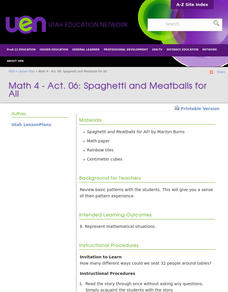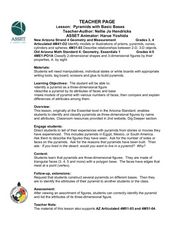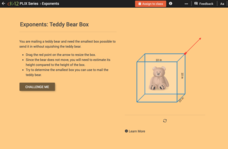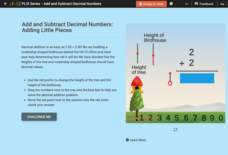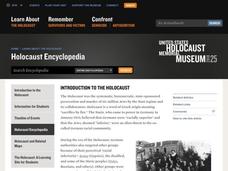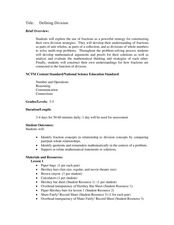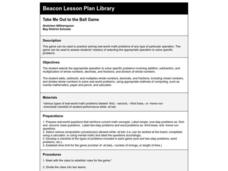Curated OER
When Are We Ever Going to USE This MATH?
Fourth graders engage in discussion of various occupations and learn where math fits into the scheme of things. They are diagnostically assessed to determine proficiency in computer, writing, and problem-solving mathematical skills set...
Curated OER
Math Quilts
Young scholars examine geometric shapes. In this geometric shape lesson plan, students examine how geometric shapes flip, turn, and slide to create a pattern. Young scholars analyze the role that quilts played in helping slaves escape...
Curated OER
Math 4 - Act. 06: Spaghetti and Meatballs for All
Fourth graders use manipulatives to practice math patterns.
Curated OER
Pyramids with Basic Bases
Students explore pyramids. In this math lesson, students discuss where they have seen examples of pyramids. Students classify pyramids as three-dimensional figures and identify their attributes.
K12 Reader
Appositive Match
Here's a worksheet that assess how well kids understand appositives. After matching a series of general nouns with words or phases that tell more about the noun, learners uses the matched set to form sentences with appositives embedded.
CK-12 Foundation
Large Decimal Rounding to Decimal Representations: Weighing a Whale
An interactive challenges mathematicians to round large numbers with help from a large scale that measures the weight of a blue whale. The practie's five questions include multiple-choice, fill-in-the-blank, true or false, and an open...
CK-12 Foundation
Whole Number Exponents: Teddy Bear Box
Five questions—multiple-choice, fill in the blank, and discussion—make up an interactive that challenges scholars to mail a teddy bear using the smallest box possible without squishing it. A box with movable sides allows mathematicians...
CK-12 Foundation
Decimal Addition: Adding Little Pieces
A five-question interactive test scholars' knowledge of adding and subtracting decimals. A tool aids in problem-solving with movable parts that reveal addends and sums. Question types include one discussion, fill and in the blank, and...
Curated OER
Locating Fractions Greater than One on the Number Line
Supplement your lesson on improper fractions with this simple resource. Working on number lines labeled with whole numbers between 0 and 5, young mathematicians represent basic improper fractions with halves and thirds. The fractions...
Curated OER
Key Understandings In The Elementary Math Classroom
Learners participate in "Key Understandings in the Elementary Mathematics Classroom" that contains examples of anchor questions that can be used to provide a snapshot of each student's ability based on one of the expectations in each...
Baylor College
What's That Food?
Get things cooking with the first lesson in this series on the science of food. Working in small groups, young scientists make and record observations about different mystery foods. These descriptions are then shared with the class and...
Curated OER
Defining Division
Upper graders explore division through fair-shares. They will review fair shares and fractions as a segway into division. They start by playing "Share Fairly" game and create mathematical arguments for solving problems. Manipulatives and...
Curated OER
Fact Families - 6, 7, and 42
Students investigate the problems that can be solved only using the numbers 6, 7, and 42. They write the correct number sentences and solve for the solution. Students then give a written explanation for how the problem was solved and the...
Curated OER
Investigation Area of Geometric Shapes
Fourth graders use triangle paper to design patterns using geometric figures and find the areas of those figures by counting units. Students are assessed by determining which figure has the greatest area and explaining their reasoning.
Curated OER
Does Your Rectangle Have Guts?
Does it? Kids find the perimeter and area of different shapes to assess whether their rectangle has guts. In addition to finding the area of a rectangle, learners work to find the area of a trapezoid. All worksheets are included.
Curated OER
Mandala Geometry
Students compare and contrast symbols and images in traditional Buddist and Hindu mandalas and choose several symbols that have meaning to them. They assess the spiritual beliefs and representations in traditional creation of this art...
Readington Township Public Schools
Facts Practice Using Multiplication/Division Fact Triangles
Why waste time teaching multiplication and division facts separately, when this resource allows you to cover both concepts at once. Displaying the fact families for all single-digit factors, these triangle shaped flash cards are a great...
Curated OER
Take Me Out to the Ball Game
Students play a math game which assesses their mastery of selecting the appropriate operation to solve specific problems.
Curated OER
Computer Olympics
Students compete to achieve excellence in math facts, writing terms, problem solving, and writing skills on the computer. In this Computer Olympics lesson plan, students practice the skill of drill and practice in order to succeed and...
Curated OER
Find a New Name: Equivalent Fractions
Fourth graders find new names for fractions. In this equivalent fractions lesson plan, 4th graders use manipulatives to model fractions and rename them. Students recognize that the new names show equivalent fractions. Students explain...
Curated OER
Operations with Signed Numbers
Students complete a variety of activities to comprehend concepts of operations with signed numbers. The integration of technology make the delivery of the lesson much more exciting for Students.
Curated OER
Family at Home
Students fold paper to form a house, then use three numbers to make fact families for their houses. They write a family of multiplication and division facts on a piece of paper cut in the shape of a house.
Pennsylvania Department of Education
Problem Solving by Using Multiplication to Solve Division Problems
Learners use index cards, counting cubes, and their own understanding to identify how division problems can be solved by using multiplication. In this division lesson plan, students use their multiplication skills to solve division...
Curated OER
Describing Patterns
Fourth graders investigate repeating and growing patterns. Models, graphs and words are used to describe, extend and represent patterns. Students use evidence from models and graphs to support the identification of patterns.




